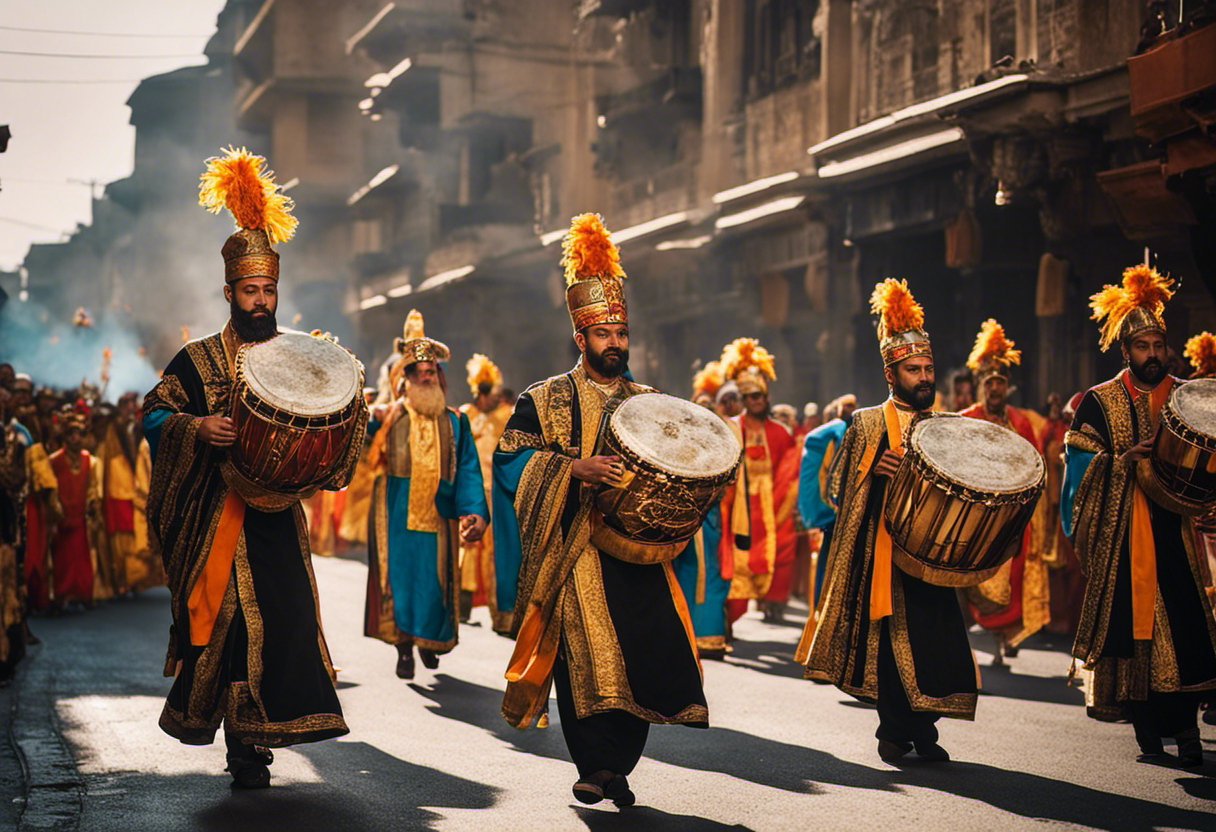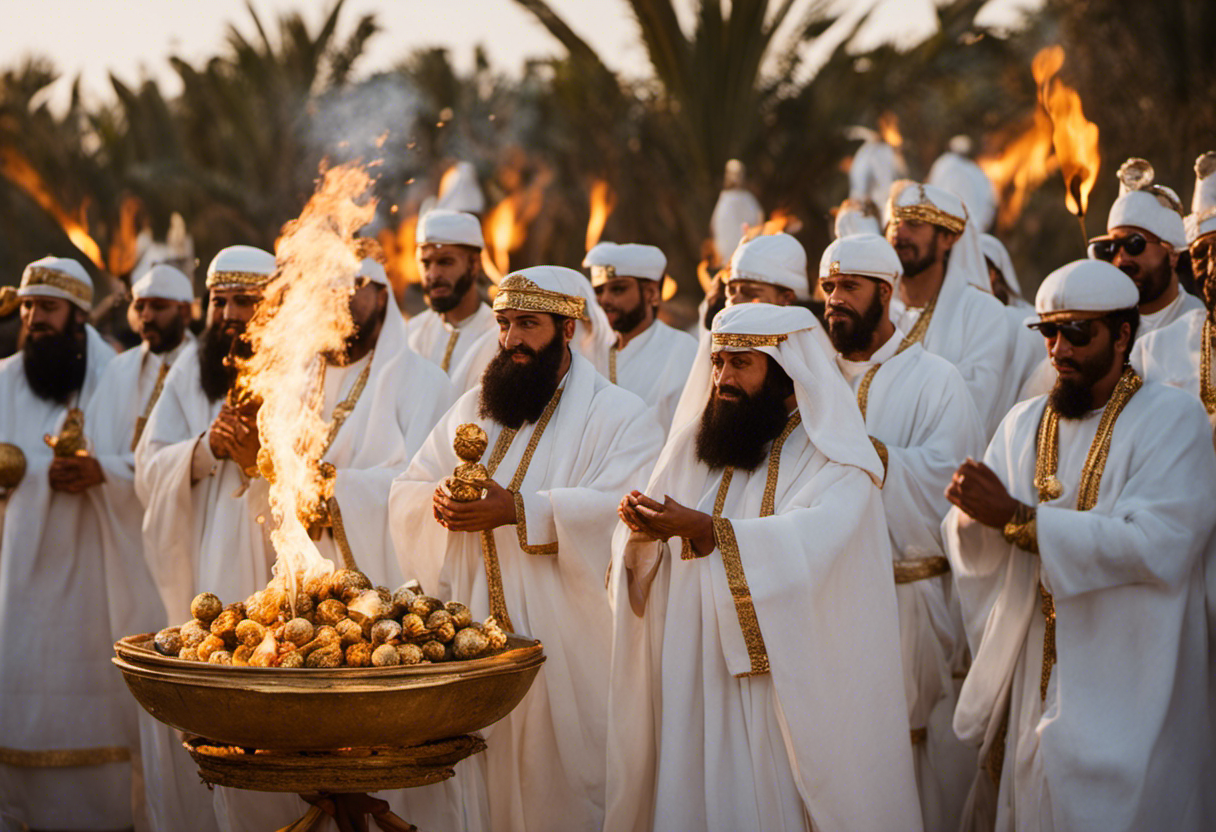The Babylonian New Year, an ancient tradition steeped in mystery and symbolism, offers a captivating glimpse into the rich culture of Mesopotamia. As we delve into the depths of this annual celebration, we are transported back in time to a world where rituals and ceremonies held great significance.
From the origins of the New Year processions to the role of the priests in these ancient rituals, join us on a journey to uncover the traditions and rituals that marked the Babylonian New Year.
Key Takeaways
- The Babylonian New Year is believed to have been celebrated as early as the third millennium BCE and is linked to the creation of the world according to Babylonian mythology.
- The festival marked the beginning of the agricultural year, the renewal of the king’s power, and reinforced social order and religious beliefs.
- The priests played a crucial role in the Babylonian New Year rituals, serving as guardians of tradition, intermediaries between humans and gods, and providers of moral and spiritual guidance.
- Symbolism and rituals of purification, such as cleaning homes and conducting cleansing ceremonies, were important in preparing for the New Year, providing a clean slate and fresh start for individuals and communities.
The Origins of the Babylonian New Year


The exact origins of the Babylonian New Year remain uncertain, as historical records only provide limited information on the early celebrations. However, based on available evidence and mythological accounts, it is believed that the Babylonians celebrated their New Year as early as the third millennium BCE.
The Babylonian New Year, known as Akitu, was a significant festival that marked the beginning of the agricultural year and the renewal of the king’s power. According to Babylonian mythology, the New Year celebration was closely linked to the creation of the world. It was believed that the god Marduk defeated the chaos monster Tiamat and created the world from her body.
The Babylonians saw the New Year as a time of renewal and rebirth, much like the creation of the world. The festival lasted for twelve days and involved various rituals, including the reenactment of Marduk’s victory over Tiamat. The Babylonian New Year was also a time for the king to reaffirm his role as the ruler and protector of the city-state.
During the festival, the king would participate in sacred marriage rites with the goddess Inanna, symbolizing the union between the divine and the earthly realms. This ritual was believed to ensure the fertility of the land and the prosperity of the people.
The Significance of the New Year Processions


Annually, during the Babylonian New Year celebrations, elaborate processions were conducted to commemorate the significance of the festival and honor the gods. These processions held both cultural and historical significance in ancient Babylonian society.
The cultural significance of the processions can be seen in their role in reinforcing social order and religious beliefs. The processions allowed the community to come together and participate in a collective act of worship, which fostered a sense of unity and solidarity among the people.
The historical origins of the processions can be traced back to ancient Mesopotamia, where they were an integral part of the New Year festivities. The Babylonians believed that these processions were essential for ensuring the continued prosperity and well-being of their kingdom. They viewed the gods as active participants in the procession, with each deity representing a different aspect of life, such as fertility, war, or wisdom.
During the processions, the Babylonians would carry statues of the gods through the city, accompanied by musicians, dancers, and priests. The streets would be adorned with flowers and decorations, creating a festive atmosphere. The processions would culminate in the temple, where offerings and prayers were made to the gods.
Overall, the processions during the Babylonian New Year celebrations held great cultural significance, as they allowed the community to come together and honor the gods. They also had historical origins dating back to ancient Mesopotamia and played a crucial role in ensuring the prosperity and well-being of the kingdom.
The Role of the Priests in Babylonian New Year Rituals


As custodians of religious traditions, priests played a vital role in overseeing and conducting the Babylonian New Year rituals, ensuring the proper observance and supplication to the gods. These rituals held great importance in the Babylonian society, as they were believed to bring blessings and ensure a prosperous year ahead.
The role of the priests in these rituals can be understood in the following ways:
- Guardians of Tradition: Priests were responsible for preserving and passing down the knowledge of the rituals from one generation to another. They upheld the ancient customs and ensured their continuity.
- Intermediaries between Humans and Gods: The priests acted as mediators between the people and the deities, offering prayers, sacrifices, and supplications on behalf of the community. They sought to establish a connection between the mortal world and the divine realm.
- Conducting Sacred Ceremonies: It was the duty of the priests to perform the rituals with utmost precision and accuracy. They recited sacred hymns, made offerings, and performed various symbolic acts to appease the gods and invoke their blessings.
- Moral and Spiritual Guidance: Priests also provided moral and spiritual guidance to the people. They interpreted the signs and omens, offered advice, and ensured that the community followed the prescribed religious principles.
The role of the priests in Babylonian New Year rituals was crucial in maintaining the religious and social fabric of the society. Their presence and involvement ensured the proper observance of the rituals and the fulfillment of the people’s spiritual needs.
Symbolism and Rituals of Purification for the New Year


Symbolism and rituals of purification for the New Year are deeply ingrained in many cultures, as they seek to cleanse and renew both the physical and spiritual aspects of individuals and communities. These symbolic gestures and cleansing ceremonies hold great significance and are often performed with the belief that they can rid individuals and their surroundings of negative energy, bad luck, and impurities.
In many cultures, the New Year is seen as a fresh start, a time to leave behind the past and embrace new beginnings. Symbolic gestures such as cleaning homes, wearing new clothes, and discarding old possessions are common. These actions symbolize the removal of physical and emotional clutter, allowing for a clean slate and a fresh start.
Cleansing ceremonies are also prevalent in many cultures during the New Year period. These ceremonies often involve the use of water, fire, or specific rituals and prayers. Water is considered a purifying element in many traditions, symbolizing renewal and rebirth. Fire, on the other hand, is seen as a transformative force that can burn away negativity and purify the soul.
Overall, the symbolism and rituals of purification for the New Year serve as a way for individuals and communities to cleanse themselves of the past and start anew. They provide a sense of renewal and hope, bringing people together in the pursuit of a fresh start and a brighter future.
The Feast of Akitu: Celebrating the Babylonian New Year


Every year, the Babylonians enthusiastically gather to celebrate the Feast of Akitu, marking the beginning of their New Year with vibrant festivities and ancient rituals. This celebration holds great significance for the Babylonian people, as it symbolizes the renewal of life and the hope for a prosperous year ahead. The Feast of Akitu is known for its elaborate feast preparations and the donning of traditional costumes, which add to the festive atmosphere.
Here are four key aspects of the Feast of Akitu that evoke emotion in the audience:
- Rituals of Renewal: The Babylonians engage in various rituals aimed at purifying themselves and their surroundings, symbolizing a fresh start for the New Year. These rituals involve cleansing ceremonies, prayers, and the casting out of evil spirits, creating a sense of renewal and optimism.
- Cultural Pride: The Feast of Akitu allows the Babylonian people to showcase their rich cultural heritage and traditions. Through their traditional costumes and performances, they express a deep sense of pride in their ancestry and their connection to the ancient civilization of Babylon.
- Community Bonding: The celebration of the Feast of Akitu brings the Babylonian community together, fostering a sense of unity and togetherness. The shared experience of participating in the festivities creates a strong bond among the people, reminding them of their collective identity and shared values.
- Anticipation and Excitement: The preparations for the Feast of Akitu generate a sense of anticipation and excitement among the Babylonian people. The weeks leading up to the celebration are filled with hustle and bustle as they prepare the feasts, decorate their homes, and buy or create their traditional costumes. This anticipation builds up as the day of the feast draws closer, creating a palpable excitement in the air.
Overall, the Feast of Akitu is a joyous celebration that brings the Babylonian people together to honor their traditions and welcome the New Year with hope and optimism.
Conclusion
In conclusion, the Babylonian New Year was a significant event filled with traditions and rituals that held great importance in their society. The New Year processions, led by the priests, symbolized the renewal and purification of the community.
Through various rituals, the Babylonians sought to cleanse themselves and their surroundings, preparing for a fresh start in the new year.
The Feast of Akitu served as a joyful celebration of the Babylonian New Year, marking the beginning of a new cycle of life.



